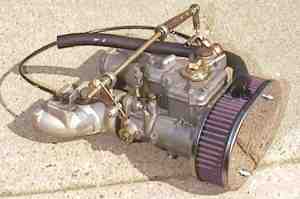|
|
|||||||||
|
||||||||||||||||||||
The Comparison.
Running a single DCOE 45 vs. twin DCOE 40's
|
This site is progressively being updated as the
on-going tests are completed. The information being documented here will compare tuning
and performance issues for running a single DCOE 45 carburetor vs. running twin DCOE 40
carburetors. The test platform for this round is a 1978 Triumph Spitfire. Our test bed is 0.040" overbore bring the volume up to 1534 cc. It is using TR6 Flattop pistons (they just happen to be spit + 040"), which together with some mild head shaving, brings the compression up to 9.93:1. It has stock size valves and very mild port cleaning and polishing. It is also running a mild street cam. Direct measurements of valve lift at the valve is 0.340". We're using a Mallory Dual Point ignition system, (mechanical advance only) set to a max advance of 26°BTDC. The power band explored should not be affected by LCB (long center branch) header scavenging effects. We are purposely using a 4 into one, with a free flow exhaust and muffler. |
![]()
 DCOE 45 152 |
|
The single DCOE 45 is mounted on a Pierce manifold via a 'soft-mount' gasket system. This isolates small dynamic vibrations that can effect emulsion tube and various chamber internal chamber 'fuel level' |
The pair of DCOE 40's being used are mounted on twin 'parallel port' Cannon manifolds, via a soft-mount system. At this stage a throttle linkage still needs to be decided on. The manifolds have already been modified with crossover pipes |
![]()
Well before I get into all the technical stuff, here's a few photos of the two setups and the test platform.
This is just a visual comparison of the two carb schemes. The 45 has been on the car for the last 250 miles. The recent winter weather has slowed me down just a bit. But testing will get going again very soon.

 Just a couple
of comparison shots. I'm in the middle of figuring out linkages, spacing, filter size
selection and piping routings.
Just a couple
of comparison shots. I'm in the middle of figuring out linkages, spacing, filter size
selection and piping routings.
One thing I like already. The dual DCOE 40 setup from manifold to filter edge, is roughly 1.5" shorter. That means I can run longer ram pipes than what I can use with the DCOE 45. The 45 as installed, is running 26mm ram pipes inside a 2" deep air filter. This setup give me only 1/4"-1/2" of clearance with the bonnet when opening and closing it.
With the shorter manifold length, I'll be able to go up to say, a 3" deep filter. This will allow me to run up to 39mm long ram pipes.
The present DCOE 45 air filter setup is a K&N free
flow unit. At present, I'm looking at developing a single box K&N filter system that
either: 1) wraps around both carbs (almost modeling the single carb design, or the
logo plate MGB, Sprite and Midget units) or 2) A Plenum at the carbs, with a
tube for a cold air feed from a Single large K&N filter mounted in front of the
radiator.
...we'll have to see how it goes...
![]()
 Cross over pipes
Cross over pipes This is the crossover porting built from copper
piping and brass compression fittings. The entries into the manifold throats were ground
flush to match the profiles of the inner walls. The 'T' between manifolds (with the large
outside thread) has not been tightened yet. This is the valve cover connection, and will
be tightened after the carbs are mounted to the head. This allows for carb to carb,
center-to-center variations.
You may ask why would you port the individual runners together? I
believe for road use, a small amount of bleed over helps steady state cruising. Plus, to
maintain proper crankcase pressure (vacuum) you still need a crankcase to intake vacuum
tap.
The last little section of piping (that will connect
to the valve cover), is designed to be 'crimped' to limit pressure pulses. Hence,
the four throats would share a more common vacuum pulse interaction in comparison to that
of any flowing into/out of, the crankcase. A standard in-line PCV valve will also be
installed and tested here, as well as simply testing a 'crimped' connection to regulate
the crankcase pressure.
![]()
These tables list my initial Jettings used for this first round of testing. Why I'm starting with these settings is whole 'nother story of it's own. I hope to add full road dyno info concerning the settings and testing results of whatever jetting configuration is found to work the best.
|
|
||||||||||||||||||||||||||||||||||||||||||||||||||||||||||||||||||||||||||||